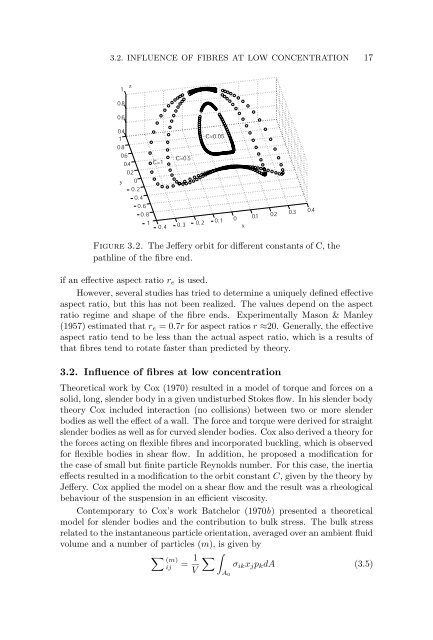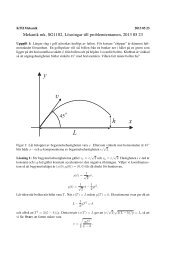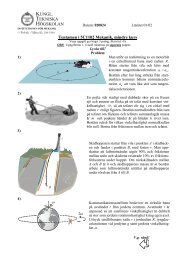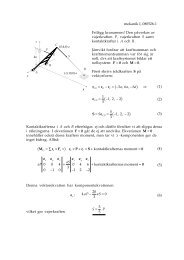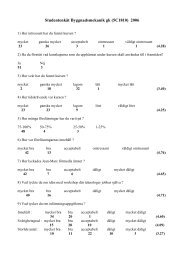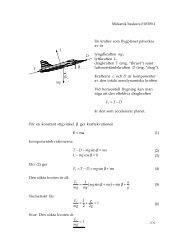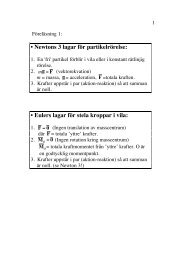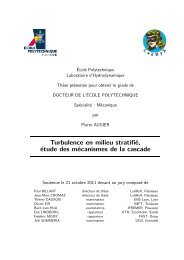Fluid mechanics of fibre suspensions related to papermaking - DiVA
Fluid mechanics of fibre suspensions related to papermaking - DiVA
Fluid mechanics of fibre suspensions related to papermaking - DiVA
You also want an ePaper? Increase the reach of your titles
YUMPU automatically turns print PDFs into web optimized ePapers that Google loves.
3.2. INFLUENCE OF FIBRES AT LOW CONCENTRATION 17<br />
1<br />
0.8<br />
0.6<br />
0.4<br />
1<br />
0.8<br />
0.6<br />
z<br />
0.4<br />
0.2<br />
y 0<br />
0.2<br />
0.4<br />
0.6<br />
0.8<br />
1<br />
C=1<br />
C=0.5<br />
C=0.05<br />
0.4 0.3 0.2 0.1 0 0.1 0.2 0.3 0.4<br />
x<br />
Figure 3.2. The Jeffery orbit for different constants <strong>of</strong> C, the<br />
pathline <strong>of</strong> the <strong>fibre</strong> end.<br />
if an effective aspect ratio re is used.<br />
However, several studies has tried <strong>to</strong> determine a uniquely defined effective<br />
aspect ratio, but this has not been realized. The values depend on the aspect<br />
ratio regime and shape <strong>of</strong> the <strong>fibre</strong> ends. Experimentally Mason & Manley<br />
(1957) estimated that re = 0.7r for aspect ratios r ≈20. Generally, the effective<br />
aspect ratio tend <strong>to</strong> be less than the actual aspect ratio, which is a results <strong>of</strong><br />
that <strong>fibre</strong>s tend <strong>to</strong> rotate faster than predicted by theory.<br />
3.2. Influence <strong>of</strong> <strong>fibre</strong>s at low concentration<br />
Theoretical work by Cox (1970) resulted in a model <strong>of</strong> <strong>to</strong>rque and forces on a<br />
solid, long, slender body in a given undisturbed S<strong>to</strong>kes flow. In his slender body<br />
theory Cox included interaction (no collisions) between two or more slender<br />
bodies as well the effect <strong>of</strong> a wall. The force and <strong>to</strong>rque were derived for straight<br />
slender bodies as well as for curved slender bodies. Cox also derived a theory for<br />
the forces acting on flexible <strong>fibre</strong>s and incorporated buckling, which is observed<br />
for flexible bodies in shear flow. In addition, he proposed a modification for<br />
the case <strong>of</strong> small but finite particle Reynolds number. For this case, the inertia<br />
effects resulted in a modification <strong>to</strong> the orbit constant C, given by the theory by<br />
Jeffery. Cox applied the model on a shear flow and the result was a rheological<br />
behaviour <strong>of</strong> the suspension in an efficient viscosity.<br />
Contemporary <strong>to</strong> Cox’s work Batchelor (1970b) presented a theoretical<br />
model for slender bodies and the contribution <strong>to</strong> bulk stress. The bulk stress<br />
<strong>related</strong> <strong>to</strong> the instantaneous particle orientation, averaged over an ambient fluid<br />
volume and a number <strong>of</strong> particles (m), is given by<br />
<br />
(m) 1 <br />
ij =<br />
V<br />
<br />
σikxjpkdA (3.5)<br />
A0


